
⚠️ Affiliate Disclaimer: This post may contain affiliate links, which means I may earn a small commission — at no extra cost to you — if you make a purchase through one of these links. I only recommend products or services I genuinely trust and believe can provide value. Thank you for supporting My Medical Muse!
7 Fascinating Reasons Why You Shiver When You Are Not Cold
Shivering is your body’s natural way of warming up a rhythmic muscle activity triggered when your internal temperature dips, but what if you start trembling even when the room is warm, and you don’t feel cold at all?
It’s an unsettling experience, your muscles twitch, your teeth chatter slightly, and you may even get goosebumps. Yet, you check the thermostat, and everything seems fine.
You’re not imagining it. Shivering without feeling cold happens to many people, and it’s your body’s response to more than just temperature, it can reflect emotions, hormones, medical issues, or even subtle shifts in your nervous system.
In this post, we’ll explore seven science-backed reasons why you might shiver when you’re not cold and what each could mean for your health.
1. Emotional Reactions and “Goosebump” Triggers
Have you ever felt chills while listening to a powerful song, hearing an inspiring story, or experiencing fear or excitement? That’s your autonomic nervous system reacting to emotional stimulation.
When you feel intense emotions awe, fear, joy, or nostalgia, your body releases adrenaline, the same hormone involved in the fight-or-flight response. Adrenaline can:
- Cause your small muscles (called arrector pili) to contract
- Create goosebumps
- Trigger brief, fine muscle contractions, that is, shivering
These emotional chills are harmless and often short-lived. They’re your brain’s way of physically expressing strong emotion, a phenomenon sometimes called “frisson.”
Fun fact: People who experience emotional chills more often may have higher emotional sensitivity and deeper empathy responses.
2. Anxiety or Panic Attacks
Shivering can also be a physical sign of anxiety. When your body senses danger, even imagined danger, it activates the sympathetic nervous system, flooding your bloodstream with stress hormones like adrenaline and cortisol.
These chemicals prepare you to fight or flee, and they can make your muscles tremble involuntarily. That’s why you might notice trembling hands, shaky legs, or even jaw quivers when you’re:
- Nervous before a presentation
- Anxious in social settings
- Overwhelmed by panic or fear
This type of shivering isn’t about body temperature, it’s about emotional temperature. Your brain interprets stress as a threat and kicks your body into high alert.
Slow, deep breathing, grounding exercises, and progressive muscle relaxation can help calm the nervous system and reduce this kind of shivering.
3. Sudden Drop in Blood Sugar (Hypoglycemia)
If you’ve skipped a meal or gone long without eating, and suddenly start trembling, low blood sugar could be the reason.
Your body needs glucose to fuel every cell, especially the brain. When blood sugar drops below normal levels, your body releases adrenaline to raise it and one side effect of adrenaline is shivering or trembling.
You might also experience:
- Dizziness or lightheadedness
- Sweating
- Rapid heartbeat
- Hunger or nausea
- Irritability or confusion
If this sounds familiar, eat something containing carbohydrates and protein such as fruit with yogurt or a peanut butter sandwich to stabilize your levels.
Frequent unexplained trembling or weakness after eating may indicate insulin resistance, prediabetes, or hypoglycemia-related conditions. Consult a doctor if it happens often.
4. Fever or Infection
Sometimes, your body shivers even when you’re burning with fever, which can feel confusing, but this happens because your brain’s temperature control center (the hypothalamus) has reset your “internal thermostat”.
When infection or inflammation triggers an immune response, your hypothalamus raises your body’s target temperature to help fight off pathogens. But your muscles and skin haven’t caught up yet, so your body temporarily feels cold, even though your temperature is rising.
Result? You start shivering uncontrollably, as your muscles generate heat to reach the new temperature set point.
Once your fever “breaks” and the set point returns to normal, you may sweat profusely, your body’s cooling system taking over.
Example, Shivering is a classic early symptom of infections like malaria, urinary tract infections (UTIs), pneumonia, or even mild viral illnesses.
5. Hormonal Fluctuations
Hormones regulate nearly everything including how your body perceives temperature. Sudden hormonal shifts can confuse your internal thermostat and make you shiver unexpectedly.
Some key examples:
- Menstrual cycle changes: Estrogen and progesterone levels fluctuate, affecting blood flow and heat sensitivity. Some women shiver or feel chills right before their period.
- Menopause: Hot flashes are well-known, but post-flash chills are also common as your body cools down too quickly afterward.
- Thyroid disorders: An underactive thyroid (hypothyroidism) slows metabolism and may cause cold intolerance, fatigue, and unexplained shivering.
Hormonal causes of shivering tend to develop gradually but can persist until the underlying imbalance is corrected.
What to do: If your shivers come with other symptoms like weight changes, irregular cycles, or fatigue, consider checking your thyroid and reproductive hormone levels.
6. Nervous System or Medication Effects
Your nervous system tightly controls involuntary movements, including shivering. When its function is disrupted, whether by medications or neurological issues, you might experience tremors or chills without cold exposure.
Common causes include:
- Medications: Antidepressants (like SSRIs), asthma drugs, and certain antipsychotics can affect neurotransmitters like dopamine or serotonin, leading to fine tremblingor muscle twitching.
- Caffeine or stimulants: Too much coffee, energy drinks, or nicotine overstimulate your nerves, producing jitteriness or mild shaking.
- Neurological disorders: Conditions like Parkinson’s disease, multiple sclerosis (MS), or peripheral neuropathy can cause involuntary tremors, sometimes mistaken for shivering.
If the trembling is frequent, persistent, or accompanied by muscle weakness, numbness, or coordination problems, it’s best to see a neurologist for evaluation.
7. Strong Physical or Sensory Stimuli
Your body can also shiver in response to intense sensory or physical experiences, even when there’s no emotional or thermal cause. Examples include:
- Hearing a powerful piece of music or watching a moving scene (sensory frisson)
- Experiencing sudden pain
- Intense physical exertion or post-exercise cooling
- Exposure to certain smells or tactile sensations
In these cases, shivering acts as a neuromuscular reflex, your body’s brief “reset” in response to overwhelming input.
Post-exercise chills, for instance, happen because your body cools too quickly after sweating and vasodilation. Your core temperature temporarily drops, leading to transient shivering even if you’re indoors.
When Shivering Isn’t Normal
Occasional trembling or a brief episode of shivering is usually harmless especially if it happens after a strong emotion, a workout, or skipping a meal but when shivering becomes frequent, persistent, or appears without any clear reason, it may be your body’s way of signaling that something deeper is going on.
Think of it as your body’s “check engine” light, a subtle sign that your internal systems need attention.
You should see a doctor if you notice any of the following:
- Shivering with fever, confusion, or extreme fatigue: These can indicate an infection or systemic illness that’s taxing your body’s energy reserves.
- Trembling that interferes with daily tasks: If your hands shake while holding objects or performing routine activities, it could be neurological or medication-related.
- Shivers with dizziness, palpitations, or sweating: These symptoms point toward possible blood sugar imbalances, hormonal changes, or anxiety-related causes.
- Sudden onset after starting a new medication: Certain prescriptions including antidepressants, asthma inhalers, or mood stabilizers can trigger tremors as a side effect.
- Long-term weight loss, mood swings, or weakness: These systemic signs may suggest thyroid dysfunction, metabolic changes, or chronic infection.
While it’s tempting to dismiss these episodes as “just nerves” or “stress,” repeated unexplained shivering deserves medical evaluation.
Underlying causes can range from mild to serious, including:
- Thyroid disorders (hypothyroidism or hyperthyroidism)
- Anxiety or panic disorders
- Neurological conditions such as essential tremor or Parkinson’s disease
- Chronic infections that alter metabolism or immune response
- Hormonal imbalances related to menopause, adrenal fatigue, or blood sugar instability
The good news? Most of these conditions are treatable or manageable once properly diagnosed. The key is to recognize when your body’s signals go from occasional to persistent.
How to Stop Shivering When You’re Not Cold
If your shivering has nothing to do with actual cold exposure, the solution isn’t just about putting on a sweater, it’s about addressing the root cause. Here are practical, science-backed strategies you can start today to calm your body and regain control.
1. Calm Your Nervous System
Stress and anxiety are powerful triggers for non-cold shivering. When your nervous system senses danger real or imagined, it activates your body’s “fight or flight” mode. Adrenaline floods your bloodstream, causing muscle tension and trembling.
Try these simple techniques to reset your nervous system:
- Deep breathing: Inhale slowly for 4 seconds, hold for 2, exhale for 6. Repeat several times to lower heart rate and cortisol levels.
- Grounding with the 5-4-3-2-1 method: Identify five things you can see, four you can touch, three you can hear, two you can smell, and one you can taste. This helps bring you back to the present moment.
- Progressive muscle relaxation: Tense and release one muscle group at a time, from head to toe, to relieve internal tension.
Practicing these daily not only reduces trembling but also improves your body’s resilience to future stress triggers.
2. Stabilize Blood Sugar
One of the most overlooked reasons for sudden trembling is low blood sugar (hypoglycemia). When your glucose levels drop, your body releases adrenaline to raise them and that surge can make you shake or shiver.
Keep your blood sugar steady by:
- Eating balanced meals every 3-4 hours containing complex carbohydrates (like oats, brown rice, or sweet potatoes), lean proteins, and healthy fats.
- Avoiding refined sugars and caffeine, which can cause rapid spikes followed by crashes.
- Including snacks like nuts, fruits, or yogurt between meals to maintain energy levels.
If you frequently experience trembling after long gaps between meals, carry a small carbohydrate source (like a banana or granola bar) to prevent sudden drops.
3. Stay Hydrated
Dehydration can subtly increase muscle fatigue, tension, and even tremors. When your body lacks water, electrolyte balance shifts, affecting muscle contractions and nerve communication.
Here’s how to stay properly hydrated:
- Drink 2-3 liters of water daily, adjusting for weather and activity levels.
- Replenish electrolytes after heavy sweating or exercise with natural options like coconut water or diluted fruit juice.
- Limit diuretics like coffee and alcohol, which can worsen dehydration.
A well-hydrated body maintains steady blood flow, temperature balance, and smoother muscle control, reducing random shivers.
4. Balance Hormones Naturally
Hormones have a direct impact on how your body regulates temperature, metabolism, and energy. Even mild imbalances can confuse your internal thermostat, triggering chills or trembling.
To support hormonal balance naturally:
- Prioritize sleep: Aim for 7-9 hours per night. Deep sleep helps regulate cortisol, estrogen, and thyroid hormones.
- Exercise moderately: Activities like brisk walking, swimming, or yoga enhance circulation and stabilize hormones.
- Manage chronic stress: High cortisol can disrupt estrogen, progesterone, and thyroid function all linked to thermoregulation.
- Eat hormone-supportive foods: Include omega-3s (salmon, flaxseed), leafy greens, whole grains, and adaptogenic herbs like ashwagandha or maca (consult your doctor first).
If symptoms like irregular cycles, night sweats, or fatigue accompany your shivering, consider requesting a hormone profile test.
5. Review Your Medications
Certain prescription or over-the-counter medications can cause shivering or tremors as side effects, especially those that affect the brain’s neurotransmitters or stimulate the nervous system.
Common culprits include:
- Antidepressants (SSRIs/SNRIs) such as fluoxetine or sertraline
- Asthma or allergy medications containing beta-agonists
- Antipsychotics and mood stabilizers
- Stimulants used for ADHD treatment
- Caffeine or nicotine products in excessive amounts
If you recently began a new medication and noticed trembling soon after, talk to your healthcare provider. They may adjust your dosage or suggest an alternative with fewer side effects.
Never stop any medication abruptly, doing so can cause withdrawal symptoms or worsen your condition.
6. Check for Underlying Illness
If you’ve ruled out stress, diet, or medication and your shivering still persists, it’s time to look deeper. Chronic or unexplained trembling may stem from internal health issues that require medical attention.
Ask your doctor about:
- Blood glucose and thyroid tests: To rule out diabetes, hypoglycemia, or thyroid imbalances.
- Hormone profile: Especially if your symptoms coincide with menstrual changes, menopause, or fatigue.
- Infection or inflammation markers: To detect lingering viral or bacterial infections that could affect your metabolism.
- Neurological assessment: If your shivering is persistent, asymmetrical, or affects coordination, it may indicate a tremor disorder that needs specialized care.
Getting a full medical workup can identify underlying causes early, when they’re easiest to treat.
When your body shivers for no clear reason, it’s rarely random. Every tremor, chill, or muscle flutter tells a story about what’s happening inside, whether it’s stress, hormones, blood sugar, or something deeper.
Most cases resolve with small lifestyle adjustments- eat regularly, sleep well, stay hydrated, and manage stress, but if your shivering is recurrent, worsening, or paired with other unusual symptoms, don’t ignore it. Your body’s messages are meant to guide you, not scare you with awareness, self-care, and timely medical support, you can regain full control and help your body find calm and balance again.
How the Body’s “Thermostat” Works
To understand why shivering happens outside cold environments, it helps to know how your hypothalamus works. This small but powerful brain region:
- Monitors your body temperature
- Coordinates responses like sweating, vasodilation, or shivering
- Reacts to emotional and hormonal signals
So, even without external cold, the hypothalamus may trigger shivering if it perceives a need, due to stress, hormones, or chemical changes. In short, your body sometimes “acts cold” even when it isn’t.
Mind-Body Connection: Why Feelings Can Make You Physically Shiver
Emotions and physical reactions are deeply intertwined. For instance:
- Fear heightens alertness and muscle tension
- Awe or inspiration releases dopamine and chills of excitement
- Anxiety sends adrenaline surging through the bloodstream
These physiological responses can create momentary shivers, evidence that your emotional brain and physical body are in constant dialogue.
In essence, your shiver might not mean “I’m cold.” It might mean “I’m feeling something deeply.”
Frequently Asked Questions
Can dehydration cause shivering?
Yes. Low hydration reduces blood volume and can temporarily affect blood pressure and body temperature regulation, leading to shivers or lightheadedness.
Is shivering the same as trembling?
Not exactly. Shivering usually refers to rhythmic muscle contractions for heat generation, while trembling can be caused by nerves, fatigue, or medication side effects.
Why do I shiver after eating?
Post-meal shivering (or “food chills”) may occur if digestion redirects blood flow to your gut, temporarily lowering skin temperature. Low blood sugar before eating can also play a role.
Can anxiety cause shivering even when I’m calm?
Yes, anxiety effects can linger in your body even after the mental stress fades. It may take time for adrenaline levels to normalize.
The Takeaway
Shivering isn’t always about being cold, it’s about your body communicating something. You might be anxious, low on blood sugar, hormonally imbalanced, or fighting an infection. In some cases, it’s simply your brain reacting to intense emotions or sensory input.
Most of the time, these shivers are harmless and temporary. But if they’re frequent, prolonged, or accompanied by other concerning symptoms, don’t ignore them, your body may be signaling that something needs attention. So next time you find yourself trembling in a warm room, pause for a moment, your body might not be cold, it might just be trying to tell you something important.
👩⚕️ Need Personalized Health Advice?
Get expert guidance tailored to your unique health concerns through MuseCare Consult. Our licensed doctors are here to help you understand your symptoms, medications, and lab results—confidentially and affordably.
👉 Book a MuseCare Consult NowRelated Blog Post You Might Like:
- Cold Feet and Tingling? 7 Easy At-Home Tests for Nerve Damage
- Cold Feet from Neuropathy or Poor Circulation? 7 Shocking Differences You Need to Know
- Why Am I Always Cold Even in Warm Weather?
- Why Do My Hands Swell in the Morning? 9 Surprising Reasons & Simple Fixes
- 10 Powerful Reasons Why You Get Dizzy Right Before Your Period
- 7 Surprising Reasons Why Your Body Temperature Keeps Changing Randomly


